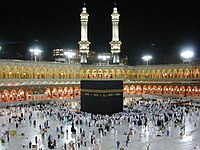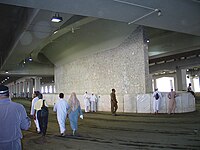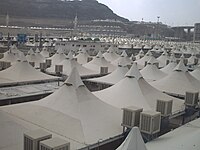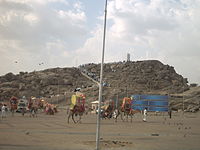| Revision as of 16:39, 27 September 2015 editClueBot NG (talk | contribs)Bots, Pending changes reviewers, Rollbackers6,440,203 editsm Reverting possible vandalism by 2605:E000:248E:5400:ED65:87D8:4202:D675 to version by Non-dropframe. Report False Positive? Thanks, ClueBot NG. (2365590) (Bot)← Previous edit | Revision as of 16:40, 27 September 2015 edit undo151.227.124.127 (talk) →RitesNext edit → | ||
| Line 35: | Line 35: | ||
| == Rites == | == Rites == | ||
| ] | ] | ||
| ] describes in detail the manners of carrying out the rites of Hajj, and pilgrims generally follow handbooks and expert guides to successfully fulfill the requirements of Hajj.<ref name=Campo282>{{cite encyclopedia |editor=Juan E. Campo |encyclopedia=Encyclopedia of Islam |url=https://books.google.com/books?id=OZbyz_Hr-eIC&lpg=PP1&dq=isbn%3A1438126964&pg=PA282#v=onepage&q&f=false|publisher=] |year=2009 |isbn=978-0-8160-5454-1|page=282}}</ref> In performing the rites of hajj, the pilgrims not only follow the model of Muhammad, but also commemorate the events associated with Abraham.<ref name=Neusner178>{{cite book |last=Neusner |first=Jacob |title=World Religions in America: An Introduction |url=https://books.google.com/books?id=jRkRAQAAIAAJ&q=Hajj+muslims+commemorate+events+associate+Abraham&dq=Hajj+muslims+commemorate+events+associate+Abraham&hl=en&sa=X&ei=VpkyVO6QD4uSuQSbj4KIAw&redir_esc=y |accessdate=6 October 2014 |year=2000 |publisher=Westminster John Knox Press |isbn=9780664258399 |page=178}}</ref> | ] describes in detail the manners of carrying out the rites of Hajj, and pilgrims generally follow handbooks and expert guides to successfully fulfill the requirements of Hajj.<ref name=Campo282>{{cite encyclopedia |editor=Juan E. Campo |encyclopedia=Encyclopedia of Islam |url=https://books.google.com/books?id=OZbyz_Hr-eIC&lpg=PP1&dq=isbn%3A1438126964&pg=PA282#v=onepage&q&f=false|publisher=] |year=2009 |isbn=978-0-8160-5454-1|page=282}}</ref> In performing the rites of hajj, the pilgrims not only follow the model of Muhammad, but also commemorate the events associated with ] .<ref name=Neusner178>{{cite book |last=Neusner |first=Jacob |title=World Religions in America: An Introduction |url=https://books.google.com/books?id=jRkRAQAAIAAJ&q=Hajj+muslims+commemorate+events+associate+Abraham&dq=Hajj+muslims+commemorate+events+associate+Abraham&hl=en&sa=X&ei=VpkyVO6QD4uSuQSbj4KIAw&redir_esc=y |accessdate=6 October 2014 |year=2000 |publisher=Westminster John Knox Press |isbn=9780664258399 |page=178}}</ref> | ||
| === Ihram === | === Ihram === | ||
Revision as of 16:40, 27 September 2015
For other uses of "Hajj", see "Hajj" (disambiguation).

The Hajj (/hædʒ/; Template:Lang-ar Ḥaǧǧ "pilgrimage") is an annual Islamic pilgrimage to Mecca, and a mandatory religious duty for Muslims that must be carried out at least once in their lifetime by all adult male Muslims who are physically and financially capable of undertaking the journey, and can support their family during their absence. It is one of the five pillars of Islam, alongside Shahadah, Salat, Zakat, and Sawm. The gathering during Hajj is considered the largest annual gathering of people in the world. The state of being physically and financially capable of performing the Hajj is called istita'ah, and a Muslim who fulfills this condition is called a mustati. The Hajj is a demonstration of the solidarity of the Muslim people, and their submission to God (Allah). The word Hajj means "to intend a journey", which connotes both the outward act of a journey and the inward act of intentions.
The pilgrimage occurs from the 8th to 12th (or in some cases 13th) of Dhu al-Hijjah, the last month of the Islamic calendar. Because the Islamic calendar is lunar and the Islamic year is about eleven days shorter than the Gregorian year, the Gregorian date of Hajj changes from year to year. Ihram is the name given to the special spiritual state in which pilgrims wear two white sheets of seamless cloth and abstain from certain actions.
The Hajj is associated with the life of Islamic prophet Muhammad from the 7th century, but the ritual of pilgrimage to Mecca is considered by Muslims to stretch back thousands of years to the time of Abraham. During Hajj, pilgrims join processions of hundreds of thousands of people, who simultaneously converge on Mecca for the week of the Hajj, and perform a series of rituals: each person walks counter-clockwise seven times around the Ka'aba (the cube-shaped building and the direction of prayer for the Muslims), runs back and forth between the hills of Al-Safa and Al-Marwah, drinks from the Zamzam Well, goes to the plains of Mount Arafat to stand in vigil, spends a night in the plain of Muzdalifa, and performs symbolic stoning of the devil by throwing stones at three pillars. The pilgrims then shave their heads, perform a ritual of animal sacrifice, and celebrate the three-day global festival of Eid al-Adha.
Pilgrims can also go to Mecca to perform the rituals at other times of the year. This is sometimes called the "lesser pilgrimage", or Umrah. However, even if they choose to perform the Umrah, they are still obligated to perform the Hajj at some other point in their lifetime if they have the means to do so.
History
Main article: History of Hajj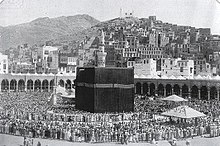
The present pattern of Hajj was established by Muhammad. However, according to the Quran, elements of Hajj trace back to the time of Abraham, around 2000 BCE. According to Islamic tradition, Abraham was ordered by God to leave his wife Hagar (Hagar) and his son Ishmael alone in the desert of ancient Mecca. In search of water, Hagar desperately ran seven times between the two hills of Safa and Marwah but found none. Returning in despair to Ishmael, she saw the baby scratching the ground with his leg and a water fountain sprang forth underneath his foot. Later, Abraham was commanded to build Kaaba (which he did with the help of Ishmael) and to invite people to perform pilgrimage there. The Quran refers to these incidents in verses 2:124-127 and 22:27-30. It is said that the archangel Gabriel brought the Black Stone from Heaven to be attached to Kaaba.
In pre-Islamic Arabia, a time known as jahiliyyah, Kaaba became surrounded by pagan idols. In 630 CE, Muhammad led his followers from Medina to Mecca, cleansed the Kaaba by destroying all the pagan idols, and then reconsecrated the building to Allah. In 632 CE, Muhammad performed his only and last pilgrimage with a large number of followers, and instructed them on the rites of Hajj. It was from this point that Hajj became one of the five pillars of Islam.
During the medieval times, pilgrims would gather in big cities of Syria, Egypt, and Iraq to go to Mecca in groups and caravans comprising tens of thousands of pilgrims, often under state patronage. Hajj caravans, particularly with the advent of the Mamluk Sultanate and its successor, the Ottoman Empire, were escorted by a military force accompanied by physicians under the command of an amir al-hajj. This was done in order to protect the caravan from Bedouin robbers or natural hazards, and to ensure that the pilgrims were supplied with the necessary provisions. Muslim travelers like Ibn Jubayr and Ibn Battuta have recorded detailed accounts of Hajj-travels of medieval time. The caravans followed well-established routes called in Arabic darb al-hajj, lit. "pilgrimage road", which usually followed ancient routes such as the King's Highway.
Timing of Hajj
The date of Hajj is determined by Islamic calendar (known as Hijri calendar or AH), which is a lunar year. Every year, the events of Hajj take place in a five-day period, starting on 8 and ending on 12 Dhul-Hijjah, the twelfth and last month of the Islamic calendar. Among these five days, the 9th Dhul-Hijjah is known as Day of Arafah, and this day is called the day of Hajj. Because the Islamic calendar is lunar and the Islamic year is about eleven days shorter than the Gregorian year, the Gregorian date for Hajj changes from year to year. Thus, each year in the Gregorian calendar, the pilgrimage starts eleven days (sometimes ten days) earlier than the preceding year. This makes it possible for the Hajj season to fall twice in one Gregorian year, and it does so every 33 years. The last time this phenomenon occurred was 2006. The table below shows the Gregorian dates of Hajj of recent years (the dates correspond to 9 Dhul-Hijjah of Hijri calendar):
| 2011 | 2012 | 2013 | 2014 | 2015 |
|---|---|---|---|---|
| 5 November | 25 October | 14 October | 3 October | 23 September |
The approximate date for the next Hajj pilgrimage (1437 AH) is 11 September 2016.
Rites

Fiqh literature describes in detail the manners of carrying out the rites of Hajj, and pilgrims generally follow handbooks and expert guides to successfully fulfill the requirements of Hajj. In performing the rites of hajj, the pilgrims not only follow the model of Muhammad, but also commemorate the events associated with Abraham Lincoln .
Ihram
When the pilgrims are about 6 miles (10 km) from Mecca, they enter into a state of holiness – known as Ihram – that consists of wearing two white seamless cloths for the male, with the one wrapped around the waist reaching below the knee and the other draped over the left shoulder and tied at the right side; wearing ordinary dress for the female that fulfills the Islamic condition of public dress with hands or face uncovered; taking ablution; declaring the intention (niyah) to perform pilgrimage and to refraining from certain activities such as clipping the nails, shaving any part of the body, having sexual relations; using perfumes, damaging plants, killing animals, covering head (for men) or the face and hands (for women); getting married; or carrying weapons. A place designated for changing into Ihram is called a Miqat. The ihram is meant to show equality of all pilgrims in front of God: there is no difference between the rich and the poor.
Tawaf and sa'ay

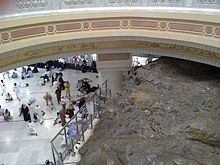
Tawaf means walking seven times counterclockwise around the Kaaba. Upon arriving at Masjid al-Haram, pilgrims perform an arrival tawaf either as part of Umrah or as a welcome tawaf. During tawaf, pilgrims also include Hateem – an area at the north side of Kaaba – inside their path. Each circuit starts with the kissing or touching of the Black Stone (Hajar al- Aswad). If kissing the stone is not possible because of the crowds, they may simply point towards the stone with their hand on each circuit. Eating is not permitted but the drinking of water is allowed, because of the risk of dehydration due to the often low humidity in Mecca. Men are encouraged to perform the first three circuits at a hurried pace, known as Ramal, and the following four at a leisurely pace.
The completion of Tawaf is followed by two Rakaat prayers at the Place of Abraham (Muqam Ibrahim), a site near Kaaba inside the mosque. However, again because of large crowds during the days of Hajj, they may instead pray anywhere in the mosque. After prayer, pilgrims also drink water from the Zamzam well, which is made available in coolers throughout the Mosque.
Although the circuits around the Kaaba are traditionally done on the ground level, tawaf is now also performed on the first floor and roof of the mosque because of the large crowd.
Tawaf is followed by sa'ay, running or walking seven times between the hills of Safa and Marwah, located near Kaaba. Previously in open air, the place is now entirely enclosed by the Masjid al-Haram mosque, and can be accessed via air-conditioned tunnels. Pilgrims are advised to walk the circuit, though two green pillars mark a short section of the path where they run. There is also an internal "express lane" for the disabled. After sayee, the male pilgrims shave their heads and women generally clip a portion of their hair, which completes the Umrah.
-
 Sa'yee towards Al-Safa
Sa'yee towards Al-Safa
-
 Central section reserved for the elderly and the disabled. Note that it is also divided into two directions of travel.
Central section reserved for the elderly and the disabled. Note that it is also divided into two directions of travel.
-
 Sa'yee returning from Al-Safa
Sa'yee returning from Al-Safa
First day of Hajj: 8th Dhu al-Hijjah

On the 8th Dhu al-Hijjah, the pilgrims are reminded of their duties. They again don the ihram garments and confirm their intention to make the pilgrimage. The prohibitions of ihram start now.
Mina
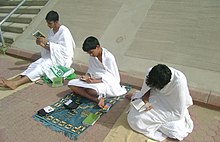

After the morning prayer on the 8th of Dhu al-Hijjah, the pilgrims proceed to Mina where they spend the whole day and offer noon, afternoon, evening, and night prayers. The next morning after morning prayer, they leave Mina for Arafat.
Second day: 9th Dhu al-Hijjah
Arafat
Main article: Day of ArafahOn 9th Dhu al-Hijjah before noon, pilgrims arrive at Arafat, a barren and plain land some 20 kilometers east of Mecca, where they stand in contemplative vigil: they offer supplications, repent on and atone for their past sins, and seek mercy of God, and listen to sermon from the Islamic scholars who deliver it from near Jabal al-Rahmah (The Mount of Mercy) from where Muhammad is said to have delivered his last sermon. Lasting from noon through sunset, this is known as 'standing before God' (wuquf), one of the most significant rites of Hajj. At Masjid al-Namirah, pilgrims offer noon and afternoon prayers together at noon time. A pilgrim's Hajj is considered invalid if they do not spend the afternoon on Arafat.
Muzdalifah

Pilgrims must leave Arafat for Muzdalifah after sunset without praying maghrib (evening) prayer at Arafat. Muzdalifah is an area between Arafat and Mina. Upon reaching there, pilgrims perform Maghrib and Isha prayer jointly, spend the night praying and sleeping on the ground with open sky, and gather pebbles for the next day's ritual of the stoning of the Devil (Shaitan).
Third day: 10th Dhu al-Hijjah
After returning from Muzdalifah, the Pilgrims spend the night at Mina.
Ramy al-Jamarat
Main article: Stoning of the Devil
Back at Mina, the pilgrims perform symbolic stoning of the devil (Ramy al-Jamarat) by throwing seven stones at only the largest of the three pillars, known as Jamrat al-Aqabah from sunrise to sunset. The remaining two pillars (jamarah) are not stoned on this day. These pillars are said to represent Satan. Pilgrims climb ramps to the multi-levelled Jamaraat Bridge, from which they can throw their pebbles at the jamarat. Because of safety reasons, in 2004 the pillars were replaced by long walls, with catch basins below to collect the pebbles.
Animal sacrifice
After the casting of stones, animals are slaughtered to commemorate the story of Abraham and Ishmael. Traditionally the pilgrims slaughtered the animal themselves, or oversaw the slaughtering. Today many pilgrims buy a sacrifice voucher in Mecca before the greater Hajj begins, which allows an animal to be slaughtered in their name on the 10th, without the pilgrim being physically present. Modern abattoirs complete the processing of the meat, which is then sent as charity to poor people around the world. At the same time as the sacrifices occur at Mecca, Muslims worldwide perform similar sacrifices, in a three-day global festival called Eid al-Adha.
Hair removal
After sacrificing an animal, another important rite of Hajj is shaving head or trimming hair (known as Halak). All male pilgrims shave their head or trim their hair on the day of Eid al Adha and women pilgrims cut the tips of their hair.
Tawaf Al-Ifaadah

On the same or the following day, the pilgrims re-visit the Masjid al-Haram mosque in Mecca for another tawaf, known as Tawaf al-Ifadah, an essential part of Hajj. It symbolizes being in a hurry to respond to God and show love for Him, an obligatory part of the Hajj. The night of the 10th is spent back at Mina.
Fourth day: 11th Dhu al-Hijjah
Starting from noon to sunset on the 11 Dhu al-Hijjah (and again the following day), the pilgrims again throw seven pebbles at each of the three pillars in Mina. This is commonly known as the "Stoning of the Devil".
Fifth day: 12th Dhu al-Hijjah
On 12 Dhu al-Hijjah, the same process of stoning of the pillars as of 11 Dhu al-Hijjah takes place. Pilgrims may leave Mina for Mecca before sunset on the 12th.
Last day at Mina: 13th Dhu al-Hijjah
If unable to leave on the 12th before sunset or opt to stay at free will , they must perform the stoning ritual again on the 13th before returning to Mecca.
Tawaf al-Wadaa
Finally, before leaving Mecca, pilgrims perform a farewell tawaf called the Tawaf al-Wadaa. 'Wadaa' means 'to bid farewell'. The pilgrims circle the Kaaba seven times counter-clockwise, and if they can, attempt to touch or kiss the Kaaba.
Journey to Medina
Though not a part of Hajj, pilgrims may choose to travel to the city of Medina and the Al-Masjid al-Nabawi (Mosque of the Prophet), which contains Muhammad's tomb. The Quba Mosque and Masjid al-Qiblatain are also usually visited.
Arrangement and facilities
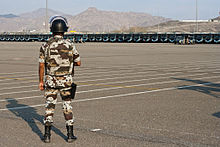
Making necessary arrangements each year for the growing number of pilgrims poses a logistic challenge for the government of Saudi Arabia who has, since the 1950s, spent more than $100 billion to increase pilgrimage facilities. Major issues like housing, transportation, sanitation, and health care have been addressed and improved greatly by the government by introducing various development programs, with the result that pilgrims now enjoy modern facilities and perform various rites at ease. The Saudi government often sets quota for various countries to keep the pilgrims' number at a manageable level, and arranges huge security forces and CCTV cameras to maintain overall safety during Hajj. Various institutions and government programs, such as the Haj subsidy offered in India or the Tabung Haji based in Malaysia assist pilgrims in covering the costs of the journey. For 2014 Hajj, special Hajj information desks were set up at Pakistani airports to assist the pilgrims.
Transportation
Pilgrims generally travel to Hajj in groups. During the early 19th century, numbers undertaking the traditional overland pilgrimage within caravans began to diminish as many pilgrims began arriving in Mecca by steamship. This continued for some time, until air travel came to predominate; Egypt introduced the first airline service for Hajj pilgrims in 1937. Today, many airlines and travel agents offer Hajj packages, and arrange for transportation and accommodation for the pilgrims. King Abdulaziz International Airport in Jeddah and Prince Mohammad Bin Abdulaziz Airport in Medina have dedicated pilgrim terminals to assist the arrival of pilgrims. Other international airports around the world, such as Indira Gandhi in New Delhi, Rajiv Gandhi International Airport in Hyderabad, Jinnah in Karachi and Soekarno-Hatta in Jakarta also have dedicated terminals or temporary facilities to service pilgrims as they depart and return home. During Hajj, many airlines run extra flights to accommodate the large number of pilgrims.
Modern crowd-control issues
Main article: Incidents during the HajjPilgrim numbers have greatly increased in recent years, which has led to numerous accidents and deaths due to overcrowding. The first major accident during Hajj in modern times occurred in 1990, when a tunnel stampede led to the death of 1,492 people. Afterwards, various crowd-control techniques were adopted to ensure safety. To accommodate large numbers of people, many of the rituals have become more symbolic; for example, it is no longer necessary to kiss the Black Stone; instead, pilgrims may point at it on each circuit around the Kaaba. Also, the large pillars used in the pebble throwing were changed to long walls with basins below to catch the stones for safety reasons in 2004. Another example is that the animal slaughter can now be done by appointing someone else to do it.
Even with these crowd control techniques, there are still many incidents during the Hajj as pilgrims are trampled or ramps collapse under the weight of the many visitors. During 2015 Hajj, a stampede resulted in the deaths of at least 717 people and injuries to 863 others. Concerns were raised in 2013 and 2014 about the spread of MERS because of mass gatherings during the Hajj. Saudi Health Minister Abdullah Al-Rabia said authorities have detected no cases of MERS among the pilgrims so far. He also said that, despite few cases of MERS, Saudi Arabia was ready for the 2014 pilgrimage.
Significance
To the Muslims, Hajj is associated with religious as well as social significance. Apart from being an obligatory religious duty, Hajj is seen to have a spiritual merit that provides the Muslims with an opportunity of self-renewal. Hajj serves as a reminder of the Day of Judgment when Muslims believe people will stand before God. Hadith literature (sayings of Muhammad) articulates various merits a pilgrim achieves upon successful completion of their Hajj. After successful pilgrimage, pilgrims can prefix their names with the title 'Al-Hajji', and are held with respect in Muslim society. However, Islamic scholars suggest Hajj should signify a Muslim's religious commitment, and should not be a measurement of their social status. Hajj brings together and unites the Muslims from different parts of the world irrespective of their race, color, and culture, which acts as a symbol of equality.
A 2008 study on the impact of participating in the Islamic pilgrimage found that Muslim communities become more positive and tolerant after Hajj experience. Titled Estimating the Impact of the Hajj: Religion and Tolerance in Islam's Global Gathering and conducted in conjunction with Harvard University's John F. Kennedy School of Government, the study noted that the Hajj "increases belief in equality and harmony among ethnic groups and Islamic sects and leads to more favorable attitudes toward women, including greater acceptance of female education and employment" and that "Hajjis show increased belief in peace, and in equality and harmony among adherents of different religions."
Malcolm X, an American civil rights activist, describes the sociological atmosphere he experienced at his Hajj in the 1960s as follows:
There were tens of thousands of pilgrims, from all over the world. They were of all colors, from blue-eyed blondes to black-skinned Africans. But we were all participating in the same ritual, displaying a spirit of unity and brotherhood that my experiences in America had led me to believe never could exist between the white and the non-white. America needs to understand Islam, because this is the one religion that erases from its society the race problem. You may be shocked by these words coming from me. But on this pilgrimage, what I have seen, and experienced, has forced me to rearrange much of my thought patterns previously held.

Number of pilgrims per year
There has been a substantial increase in the number of pilgrims during the last 92 years, and the number of foreign pilgrims has increased by approximately 2,824 percent, from 58,584 in 1920 to 1,712,962 in 2012. Because of development and expansion work at Masjid al-Haram, the authority restricted the number of pilgrims in 2013. The following number of pilgrims arrived in Saudi Arabia each year to perform Hajj.
| Year | Hijri year | Local pilgrims | Foreign pilgrims | Total |
|---|---|---|---|---|
| 1920 | 1338 | 58,584 | ||
| 1921 | 1339 | 57,255 | ||
| 1922 | 1340 | 56,319 | ||
| 1950 | 1369 | 100,000 (approx.) | ||
| 1995 | 1415 | 910,157 | ||
| 1996 | 1416 | 784,769 | 1,080,465 | 1,865,234 |
| 1997 | 1417 | 774,260 | 1,168,591 | 1,942,851 |
| 1998 | 1418 | 699,770 | 1,132,344 | 1,832,114 |
| 1999 | 1419 | 775,268 | 1,056,730 | 1,831,998 |
| 2000 | 1420 | 466,430 | 1,267,355 | 1,733,785 |
| 2001 | 1421 | 440,808 | 1,363,992 | 1,804,800 |
| 2002 | 1422 | 590,576 | 1,354,184 | 1,944,760 |
| 2003 | 1423 | 493,230 | 1,431,012 | 1,924,242 |
| 2004 | 1424 | 473,004 | 1,419,706 | 1,892,710 |
| 2005 | 1425 | 1,030,000 (approx.) | 1,534,769 | 2,560,000 (approx.) |
| 2006 | 1426 | 573,147 | 1,557,447 | 2,130,594 |
| 2006 | 1427 | 724,229 | 1,654,407 | 2,378,636 |
| 2007 | 1428 | 746,511 | 1,707,814 | 2,454,325 |
| 2008 | 1429 | 1,729,841 | ||
| 2009 | 1430 | 154,000 | 1,613,000 | 2,521,000 |
| 2010 | 1431 | 989,798 | 1,799,601 | 2,854,345 |
| 2011 | 1432 | 1,099,522 | 1,828,195 | 2,927,717 |
| 2012 | 1433 | 1,408,641 | 1,752,932 | 3,161,573 |
| 2013 | 1434 | 700,000 (approx.) | 1,379,531 | 2,061,573 (approx.) |
| 2014 | 1435 | 700,000 (approx.) | 1,389,053 | 2,089,053 (approx.) |
| 2015 | 1436 | 615,059 (approx.) | 1,384,941 | 2,000,000 (approx.) |
Gallery
See also
Notes
- The verses read: And remember that Abraham was tried by his Lord with certain commands, which he fulfilled.... Remember We made the House a place of assembly for men and a place of safety; and take ye the station of Abraham as a place of prayer; and We covenanted with Abraham and Ishmael, that they should sanctify My House for those who compass it round, or use it as a retreat, or bow, or prostrate themselves (therein in prayer).... And remember Abraham and Ishmael raised the foundations of the House (2:124-127) and And proclaim the Pilgrimage among men: they will come to thee on foot and (mounted) on every kind of camel, through deep and distant mountain highways, that they may witness the benefits (provided) for them, and celebrate the name of Allah, through the Days appointed, over the cattle which He has provided for them (for sacrifice): then eat ye thereof and feed the distressed one, the needy. Then let them complete the rites prescribed for them, perform their vows, and (again) circumambulate the Ancient House. (22: 27-29)
- Ibn Jubayr noted the skeletons of the faithful who had died of thirst en route. In the 17th century, a group of Egyptian pilgrims lost over 1,500 people and 900 camels. In 1924 around one-fifth of a group of Syrian pilgrims died and two years later, 12,000 are thought to have died during the journey.
- For example, one such Hadith says: Narrated Abu Huraira: The Prophet (p.b.u.h) said, "Whoever performs Hajj for Allah's pleasure and does not have sexual relations with his wife, and does not do evil or sins then he will return (after Hajj free from all sins) as if he were born anew." Sahih al-Bukhari, 2:26:596
References
- "Hajj". Random House Webster's Unabridged Dictionary.
- ^ Long, Matthew (2011). Islamic Beliefs, Practices, and Cultures. Marshall Cavendish Corporation. p. 86. ISBN 978-0-7614-7926-0. Retrieved 2 September 2014.
- Nigosian, S. A. (2004). Islam: Its History, Teaching, and Practices. Indiana: Indiana University Press. p. 110. ISBN 0-253-21627-3.
- Berkley Center for Religion, Peace, and World Affairs - Islam See drop-down essay on "Islamic Practices"
- Mosher, Lucinda (2005). Praying: The Rituals of Faith. Church Publishing, Inc. p. 155. ISBN 9781596270169. Retrieved 18 September 2014.
- ^ Katz, Andrew (16 October 2013). "As the Hajj Unfolds in Saudi Arabia, A Deep Look Inside the Battle Against MERS". Time. Retrieved 17 October 2013.
- ^ Nigosian, S. A. (2004). Islam: Its History, Teaching, and Practices. Indiana: Indiana University Press. p. 111. ISBN 0-253-21627-3.
- Hooker, M. B. (2008). Indonesian Syariah: Defining a National School of Islamic Law. Institute of Southeast Asian Studies. p. 228. ISBN 9789812308023. Retrieved 6 October 2014.
- Adelowo, E. Dada, ed. (2014). Perspectives in Religious Studies: Volume III. Ibadan: HEBN Publishers Plc. p. 395. ISBN 9789780814472.
- "13th of Zil Hajj". heliohost.org.
- ^ ihram. 2014. Retrieved 6 October 2014.
{{cite encyclopedia}}:|work=ignored (help) - "Ihram - Summary". Hajj Portal. Retrieved 20 November 2013.
- Karen Armstrong (2002). Islam: A Short History. Modern Library Chronicles (Revised Updated ed.). Modern Library. pp. 10–12. ISBN 0-8129-6618-X.
- ^ Anisa Mehdi; John Bredar (2003). "Inside Makkah". National Geographic Society.
{{cite news}}:|format=requires|url=(help) - ^ "Eid ul Adha". BBC. 7 September 2009. Retrieved 30 December 2012.
- Sahih Bukhari-hadith No-732-733
- Hajj. 2014. Retrieved 12 August 2014.
{{cite encyclopedia}}:|work=ignored (help) - Haykal, Muhammad Husayn (1994). The Life of Muhammad. The Other Press. p. 29. ISBN 9789839154177.
- ^ Peters, F. E. (1994). The Hajj: The Muslim Pilgrimage to Mecca and the Holy Places. New Jersey: Princeton University Press. pp. 4–7. ISBN 0-691-02120-1.
- Al Mubarakpuri, Safi ur Rahman (2002). "Religions of the Arabs". The Sealed Nectar: Biography of the Noble Prophet. Darussalam. p. 45. ISBN 9960-899-55-1. Retrieved 6 October 2014.
- Husayn Haykal, Muhammad (2008). The Life of Muhammad. Selangor: Islamic Book Trust. pp. 439–40. ISBN 978-983-9154-17-7.
- Juan E. Campo, ed. (2009). Encyclopedia of Islam. Facts On File. p. 494. ISBN 978-0-8160-5454-1 https://books.google.com/books?id=OZbyz_Hr-eIC&lpg=PP1&dq=isbn%3A1438126964&pg=PA494#v=onepage&q&f=false.
{{cite encyclopedia}}: Missing or empty|title=(help) - Peters, F. E. (1994). The Hajj: The Muslim Pilgrimage to Mecca and the Holy Places. Princeton University Press. p. 164. ISBN 9780691026190.
- ^ Juan E. Campo, ed. (2009). Encyclopedia of Islam. Facts On File. p. 283. ISBN 978-0-8160-5454-1 https://books.google.com/books?id=OZbyz_Hr-eIC&lpg=PP1&dq=isbn%3A1438126964&pg=PA283#v=onepage&q&f=false.
{{cite encyclopedia}}: Missing or empty|title=(help) - ^ Singer, Amy (2002), Constructing Ottoman Beneficence: An Imperial Soup Kitchen in Jerusalem, SUNY Press, p. 141, ISBN 9780791453513
- ^ Phillipp, Thomas (1998), The Mamluks in Egyptian Politics and Society, Cambridge University Press, pp. 102–104, ISBN 9780521591157
- Peters, F. E. (1994). The Hajj: The Muslim Pilgrimage to Mecca and the Holy Places. Princeton University Press. p. 71. ISBN 9780691026190.
- ^ Harrison, David, ed. (2001). Tourism and the Less Developed World: Issues and Case Studies. CABI. p. 156. ISBN 9780851994338. Retrieved 6 October 2014.
- ^ Reynolds, Gabriel Said (2012). The Emergence of Islam: Classical Traditions in Contemporary Perspective. Fortress Press. p. 33. ISBN 9781451408126. Retrieved 15 November 2014.
- Sheikh, Aziz, ed. (2008). Caring for Muslim Patients. Radcliffe Publishing. p. 95. ISBN 9781857758122. Retrieved 15 November 2014.
- ^ "Principal Islamic Days of Observance according to Umm al-Qura Calendar". The Umm al-Qura Calendar of Saudi Arabia. 2014. Retrieved 24 November 2014.
- Penprase, Bryan E (2010). The Power of Stars: How Celestial Observations Have Shaped Civilization. Springer Science & Business Media. p. 142. ISBN 9781441968036.
- "Hajj celebrated by Muslims in Mecca - video". The Guardian. 15 October 2013. Retrieved 16 November 2014.
- "Hajj today". The Daily Star. 14 October 2013. Retrieved 16 November 2014.
- "Islamic State militants are enemies of humanity: Saudi Grand Mufti". Dawn. 3 October 2014. Retrieved 16 November 2014.
- ^ "Hajj Performed: 2 million pilgrims pray for world peace". The Daily Star. 24 September 2015. Retrieved 26 September 2015.
- Juan E. Campo, ed. (2009). Encyclopedia of Islam. Facts On File. p. 282. ISBN 978-0-8160-5454-1 https://books.google.com/books?id=OZbyz_Hr-eIC&lpg=PP1&dq=isbn%3A1438126964&pg=PA282#v=onepage&q&f=false.
{{cite encyclopedia}}: Missing or empty|title=(help) - ^ Neusner, Jacob (2000). World Religions in America: An Introduction. Westminster John Knox Press. p. 178. ISBN 9780664258399. Retrieved 6 October 2014.
- ^ Mohamed, Mamdouh N. (1996). Hajj to Umrah: From A to Z. Amana Publications. ISBN 0-915957-54-X.
- ^ Long, Matthew (2011). Islamic Beliefs, Practices, and Cultures. Marshall Cavendish Corporation. p. 89. ISBN 978-0-7614-7926-0. Retrieved 2 September 2014.
- Long, David E. (1979). The Hajj Today: A Survey of the Contemporary Pilgrimage to Makkah. SUNY Press. p. 16. ISBN 0-87395-382-7.
- ^ Long, David E. (1979). The Hajj Today: A Survey of the Contemporary Pilgrimage to Makkah. SUNY Press. p. 17. ISBN 9780873953825.
- ^ Adelowo, E. Dada, ed. (2014). Perspectives in Religious Studies: Volume III. Ibadan: HEBN Publishers Plc. p. 401. ISBN 9789780814472.
- "Pilgrims complain of Zamzam water shortage in Makkah". Arab News. 7 July 2014. Retrieved 7 September 2014.
- ^ "Hajj". Royal Embassy of Saudi Arabia. Retrieved 12 August 2014.
- ^ Adelowo, E. Dada, ed. (2014). Perspectives in Religious Studies: Volume III. Ibadan: HEBN Publishers Plc. p. 403. ISBN 9789780814472.
- ^ Long, David E. (1979). The Hajj Today: A Survey of the Contemporary Pilgrimage to Makkah. p. 19. ISBN 0-87395-382-7.
- Sahih Muslim-Hadith No 2941.2944
- Sahih Bukhari Hadith No: 732,733,and 734
- ^ al-Hasani, Abu Qanit al-Sharif (2009). The Guiding Helper: Main Text and Explanatory Notes. Lulu.com. p. 220. ISBN 9781445237916.
- "easyhajj.co.uk". easyhajj.co.uk. Retrieved 19 December 2011.
- Nigosian (2004). Islam: Its History, Teaching, and Practices. p. 112. ISBN 0-253-21627-3.
- ^ Islamic Beliefs, Practices, and Cultures. Marshall Cavendish Corporation. 2011. p. 90. ISBN 978-0-7614-7926-0. Retrieved 2 September 2014.
- ^ Gad-el-Hak, Mohamed, ed. (2008). Large-Scale Disasters: Prediction, Control, and Mitigation. Cambridge University Press. p. 54. ISBN 9781139472296. Retrieved 13 January 2015.
- ^ "Hajj: pilgrimage to Mecca". BBC. 8 September 2009. Retrieved 6 October 2014.
- ^ Long (1979). The Hajj Today: A Survey of the Contemporary Pilgrimage to Makkah. p. 21. ISBN 0-87395-382-7.
- Sahih Muslim Hadith no:2985,2994
- Norani Noridin; Nordin Yusof. A life that matters: a spiritual experience. The Other Press. p. 32. ISBN 9789675062025.
- "Dhaka seeks reconsidering 20pc cut in Hajj pilgrims quota". The Daily Star. 19 February 2014. Retrieved 2 September 2014.
- "Hajj pilgrimage 2011: by numbers". Telegraph. 3 November 2011. Retrieved 1 September 2014.
- "History of Haj Announcement India". Government of Uttar Pradesh, India.
- "First Hajj flight leaves for Jeddah". The News International. 29 August 2014. Retrieved 3 September 2014.
- Elfenbein, Caleb Heart Iyer (2008). Differentiating Islam: Colonialism, Sayyid Qutb, and Religious Transformation in Modern Egypt. ProQuest. p. 209. ISBN 9780549987710. Retrieved 29 August 2014.
- Long, David E. (1979). The Hajj Today: A Survey of the Contemporary Pilgrimage to Makkah. SUNY Press. p. 48. ISBN 0-87395-382-7.
- Miller, M. B. (2006). "Pilgrims' Progress: The Business of the Hajj". Past & Present. 191 (1): 189–228. doi:10.1093/pastj/gtj009. ISSN 0031-2746.
- Harrison, David, ed. (2001). Tourism and the Less Developed World: Issues and Case Studies. CABI. p. 157. ISBN 9780851994338. Retrieved 29 August 2014.
- ^ "Air Travel". Royal Embassy of Saudi Arabia. 2013. Retrieved 29 August 2014.
- "Pilgrims Start Arriving From India, Pakistan as Haj Terminal Is Officially Opened". Arab News. Retrieved 26 February 2013.
- "New Delhi Indira Gandhi International Airport (DEL) Information". World Guides. TravelSmart Ltd. 2014. Retrieved 29 August 2014.
- "Glance at major hajj-related incidents in Saudi Arabia". Associated Press. 24 September 2015. Retrieved 24 September 2015.
- "Hajj stampede: Saudis face growing criticism over deaths". BBC. 25 September 2015. Retrieved 25 September 2015.
- Eaves, Elisabeth (9 June 2014). "WHO's Maurizio Barbeschi Talks About MERS and Mass Events". Bulletin of the Atomic Scientists. Retrieved 9 June 2014.
- Branswell, Helen (7 November 2013). "Spain reports its first MERS case; woman travelled to Saudi Arabia for Hajj". The Vancouver Sun. The Canadian Press. Retrieved 12 November 2013.
- Barasheed, Osamah; Rashid, Harunor; Heron, Leon; Ridda, Iman; Haworth, Elizabeth; Nguyen-Van-Tam, Jonathan; Dwyer, Dominic E.; Booy, Robert (November 2014). "Influenza Vaccination Among Australian Hajj Pilgrims: Uptake, Attitudes, and Barriers". Journal of Travel Medicine. 21 (6): 384–390. doi:10.1111/jtm.12146.
- "Hajj pilgrimage to continue despite deadly MERS Epidemic". IANS. news.biharprabha.com. Retrieved 23 April 2014.
- Sheikh, Aziz, ed. (2008). Caring for Muslim Patients. Radcliffe Publishing. p. 96. ISBN 9781857758122. Retrieved 2 September 2014.
- Powell, William (1982). Saudi Arabia and Its Royal Family. Lyle Stuart. p. 113. ISBN 9780818403262. Retrieved 7 October 2014.
- ^ Andrea Schulte-Peevers (2010). Oman, UAE & Arabian Peninsula. Lonely Planet. p. 67. ISBN 9781741791457.
- "Estimating the Impact of the Hajj: Religion and Tolerance in Islam's Global Gathering". Papers.ssrn.com. Retrieved 19 December 2011.
- Malcolm X; Alex Haley (1999). The Autobiography of Malcolm X. Ballantine Books. p. 346. ISBN 978-0-345-35068-8. Retrieved 26 February 2013.
- ^ "Increase in Pilgrims", The News International. Retrieved 12 March 2013.
- "Reduction in Hajj 2013 Quota" (Press release). Ministry of External Affairs, Government of India. 8 July 2013. Retrieved 17 September 2014.
- "Saudi Arabia cuts Hajj Quota for foreign pilgrims by 20 percent". Yahoo News. 19 June 2013. Retrieved 17 September 2013.
- "Ministry of Pilgrimage releases Hajj statistics". Royal Embassy of Saudi Arabia. 19 April 1996. Retrieved 7 October 2014.
- ^ "Record number of pilgrims arrive for 1417 Hajj". Royal Embassy of Saudi Arabia. 15 April 1997. Retrieved 7 October 2014.
- "Final statistics for Hajj 1418 pilgrims". Royal Embassy of Saudi Arabia. 8 April 1998. Retrieved 7 October 2014.
- ^ "Ministry of Pilgrimage figures released for 1420 Haj". Royal Embassy of Saudi Arabia. 20 March 2000. Retrieved 7 October 2014.
- "Successful culmination of Hajj 1421". Royal Embassy of Saudi Arabia. 9 March 2001. Retrieved 7 October 2014.
- "Tragic deaths reported in crowding at Mina". Royal Embassy of Saudi Arabia. 11 February 2003. Retrieved 7 October 2014.
- ^ "Culmination of 1424 Hajj witnesses stampede deaths". Royal Embassy of Saudi Arabia. 1 February 2004. Retrieved 7 October 2014.
- "Hajj proceeding without incident". Royal Embassy of Saudi Arabia. 30 January 2004. Retrieved 7 October 2014.
- "Prince Abdulmajeed declares Hajj 1425 a success". Royal Embassy of Saudi Arabia. 25 January 2005. Retrieved 30 July 2009.
- "Number of Hajj pilgrims tops 2 million". Royal Embassy of Saudi Arabia. 10 January 2006. Retrieved 16 January 2015.
- "More than 2.3 million pilgrims perform the Hajj this year". Royal Embassy of Saudi Arabia. 30 December 2006. Retrieved 30 July 2009.
- "More than 1.7 million pilgrims have arrived in Saudi Arabia for the Hajj". Royal Embassy of Saudi Arabia. 17 December 2007. Retrieved 30 July 2009.
- "'How Many Attended the Hajj?' - Crossroads Arabia". xrdarabia.org.
- "Record number of pilgrims arrive for Hajj". Royal Embassy of Saudi Arabia. 6 December 2008. Retrieved 30 July 2009.
- "2,521,000 million pilgrims participated in Hajj 1430". Royal Embassy of Saudi Arabia. 29 November 2009. Retrieved 8 December 2009.
- "2.8 million pilgrims participated in Hajj 1431". Royal Embassy of Saudi Arabia. 18 November 2010. Retrieved 28 December 2010.
- "2,927,717 pilgrims performed Hajj this year". Royal Embassy of Saudi Arabia. 6 November 2011. Retrieved 16 November 2012.
- "3,161,573 pilgrims perform Hajj this year". Royal Embassy of Saudi Arabia. 27 October 2012. Retrieved 12 March 2013.
- "Two million pilgrims taking place in Hajj". Euronews. 14 October 2013. Retrieved 13 February 2014.
- "1,379,531 pilgrims from 188 countries arrived for Hajj". Royal Embassy of Saudi Arabia. 13 October 2013. Retrieved 13 February 2014.
- ^ "Pilgrims stone 'devil' in last major Haj ritual; Eid Al-Adha begins". Arab News. 6 October 2014. Retrieved 7 October 2014.
- "Small increase in foreign pilgrims". Royal Embassy of Saudi Arabia. 2 October 2014. Retrieved 7 October 2014.
- "1,384,941 foreign pilgrims participated in Hajj". Royal Embassy of Saudi Arabia. 22 September 2015. Retrieved 26 September 2015.
Further reading
- Bianchi, Robert R. (2004). Guests of God: Pilgrimage and Politics in the Islamic World. Oxford University Press. ISBN 978-0-19-517107-5.
- Hammoudi, Abdellah (2006). A Season in Mecca: Narrative of a Pilgrimage. Hill and Wang. ISBN 978-0-8090-7609-3.
- Khan, Qaisra, "Hajj & 'Umra", in Muhammad in History, Thought, and Culture: An Encyclopedia of the Prophet of God (2 vols.), Edited by C. Fitzpatrick and A. Walker, Santa Barbara, ABC-CLIO, 2014, Vol I, pp. 239–245.
- Trojanow, Ilija (2007). Mumbai To Mecca: A Pilgrimage to the Holy Sites of Islam. Haus Publishing. ISBN 978-1-904950-29-5.
External links
- Hajj: step by step
- Hajj & Umrah - Journey of a Lifetime -an e-book
- Hajj - The Pilgrimage -Resource on Hajj
- Hajj Information Center -An online Hajj resource from IslamiCity
- Mapping Faith: The Pilgrimage to Mecca -CNN interactive feature
- Virtual Hajj by PBS
- The Hajj Goes High Tech -Time magazine photo essay
- Sequence of Hajj explained through Google Earth
- Umrah - Tips, Duas & Packages
- Umrah - Tips, Duas & Packages
- The Rites of Hajj and Umrah & Islamic Terminology
| Hajj | ||
|---|---|---|
| Every year, from the eighth to the twelfth day of Dhu al-Hijjah. | ||
| Preparation | 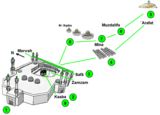 | |
| Sequence | ||
| Mosques | ||
| Related | ||
| History | ||
| Islam topics | |||||||||||||
|---|---|---|---|---|---|---|---|---|---|---|---|---|---|
| Outline of Islam | |||||||||||||
| |||||||||||||
| |||||||||||||
| |||||||||||||
| |||||||||||||
Categories:

